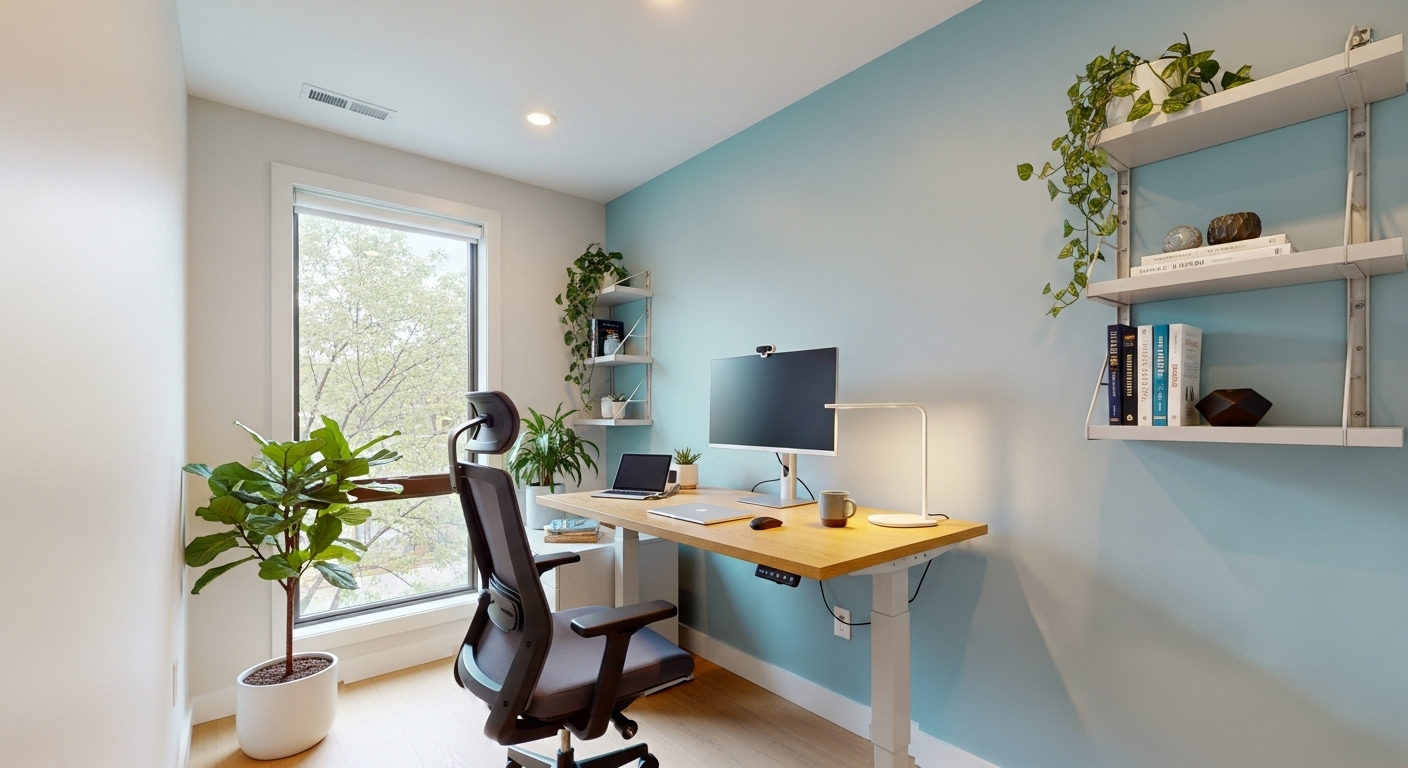The promise of a coworking space is alluring: a dynamic community, endless coffee, and a vibrant atmosphere designed to spark innovation. Yet, for many, the reality can be a frustrating paradox. The very energy that draws us in—the buzz of conversation, the movement of people, the collaborative spirit—can become the primary saboteur of our focus. How do you tap into the benefits without succumbing to the distractions? The answer isn’t about finding a better space, but about developing a better system. This is the Coworking Productivity Code, a set of principles and practices designed to help you master your environment, command your focus, and achieve peak performance. Recent trends show a massive return to flexible workspaces, but professionals are now more aware than ever of the need for intentional strategies to manage their attention. This guide will move beyond generic advice and provide a comprehensive blueprint for architecting your personal focus bubble, mastering deep work, leveraging community, and adopting the right mindset to thrive in a shared professional landscape.
Architecting Your Personal Focus Bubble
In an open-plan coworking environment, your desk is more than just a surface; it’s your command center, your sanctuary, and your primary defense against a sea of potential distractions. Architecting this personal space for maximum focus is the foundational step in the Coworking Productivity Code. It begins with strategic selection. If possible, choose a desk that faces a wall or is situated in a lower-traffic corner. This simple act of positioning minimizes unexpected visual stimuli that can pull you out of a state of flow. Once you’ve claimed your spot, ergonomics become paramount. An external monitor, keyboard, and mouse can transform a temporary hot desk into a comfortable, sustainable workstation, aligning your posture and reducing physical strain that ultimately drains mental energy. The next layer of your focus bubble is sensory control. High-quality, noise-canceling headphones are non-negotiable. They are the universal signal for ‘do not disturb’ and a powerful tool for creating an auditory environment you control. You can layer this with ambient sound apps that play everything from gentle rain to the subtle hum of a coffee shop, masking inconsistent background noise with a steady, predictable soundscape. Finally, establish visual cues. A small, unobtrusive sign or even a specific object on your desk can signal to colleagues when you are engaged in deep work and should not be interrupted. Mastering your physical setup isn’t about being antisocial; it’s about creating the necessary conditions for high-value output, ensuring that when you do choose to engage, it’s on your own terms.
Mastering Deep Work in a Dynamic Setting
Deep work, the ability to focus without distraction on a cognitively demanding task, is the currency of the modern professional. Achieving it in a quiet home office is challenging enough; doing so in a bustling coworking space requires a deliberate and disciplined approach. The key is to shift from a reactive to a proactive work style. Instead of letting the day’s rhythm dictate your focus, you must impose your own structure upon it. The Pomodoro Technique is an excellent entry point. By working in focused 25-minute intervals followed by a 5-minute break, you train your brain to concentrate intensely for short bursts, making the task feel less daunting. For more complex projects, time blocking is essential. Schedule 90-minute to 2-hour ‘deep work’ sessions into your calendar as if they were unbreakable appointments. Protect this time fiercely. This means turning off all notifications—email, Slack, and phone—and communicating your unavailability to colleagues. Be strategic about when you schedule these blocks. Observe the natural ebb and flow of your chosen coworking space. Early mornings or late afternoons are often quieter, making them ideal for tasks that require your full cognitive horsepower. A crucial, often overlooked, element is managing your ‘attentional residue.’ When you switch from one task to another, a part of your attention remains stuck on the previous task. Minimize this by creating a shutdown ritual at the end of each deep work block. A simple two-minute process of reviewing your progress and clarifying what’s next can help you mentally disengage, ensuring you’re fully present for your break or the next task on your list.
The Unwritten Rules: Productivity and Social Etiquette
A coworking space is a shared ecosystem, and its collective productivity hinges on a set of unwritten social rules. Mastering this etiquette is not just about being a good neighbor; it’s a strategic act that reduces friction and preserves the focus of the entire community, including your own. The most significant area is noise management. While headphones are a personal defense, proactive noise reduction is a community responsibility. This means taking all phone and video calls to designated phone booths or private areas. Even a ‘quick’ call at your desk can shatter the concentration of a dozen people around you. Similarly, be mindful of conversation volume. The collaborative buzz is a benefit, but lengthy, loud discussions should be moved to a lounge or meeting room. Food etiquette is another critical component. Avoid bringing strong-smelling foods to your desk; the communal kitchen is there for a reason. Keeping your personal desk and the shared areas tidy contributes to a sense of calm and order, which research has shown directly impacts cognitive performance. As one workspace manager noted,
“The visual clutter of a messy space creates mental clutter for everyone. It’s a low-level, constant distraction that chips away at focus.”
Respecting these boundaries also means understanding when and how to approach colleagues. Avoid interrupting someone who is clearly ‘in the zone’ (e.g., wearing headphones, typing furiously). If you need to speak with them, a quick Slack or Teams message asking when they have a free moment is far less intrusive. By adhering to this code of conduct, you contribute to an environment where everyone feels respected and can do their best work. This mutual understanding is the invisible architecture supporting a truly productive coworking experience.
Leveraging Community as a Productivity Catalyst
While the potential for distraction is real, the community within a coworking space is also one of its greatest assets for productivity, if leveraged correctly. The narrative often pits focus against community, but the two can be powerfully synergistic. The first benefit is ‘ambient accountability.’ Simply being surrounded by other focused, hard-working individuals creates a positive pressure to stay on task. This phenomenon, known as social facilitation, can boost performance on well-practiced tasks. You’re less likely to scroll through social media when the person next to you is intensely focused on building a financial model. The key is to harness this energy without getting pulled into conversation. Beyond passive accountability, the community is an incredible resource for problem-solving. Stuck on a technical problem or need a quick opinion on a design? Instead of spending hours searching online, you can often find an expert just a few desks away. The trick is to be intentional. Save these questions for natural break times—like when you’re making coffee—rather than interrupting someone’s deep work session. This transforms potential distractions into efficient, scheduled interactions. Furthermore, you can formalize this support system. Find an ‘accountability buddy’ in the space. Start your day with a quick, two-minute chat to state your top three goals. This simple act of verbalizing your intentions dramatically increases the likelihood you’ll follow through. The community also provides crucial mental breaks that can restore focus. A short, 10-minute coffee break with a fellow coworker can be more refreshing than 10 minutes of browsing the internet, helping to prevent burnout and providing a fresh perspective when you return to your desk.
Your Essential Tech Stack for Shared Space Success
In a coworking environment, your technology is not just for doing your work; it’s a critical part of your toolkit for managing your focus and interactions. A well-curated tech stack can create a digital fortress around your attention, even in the most open of spaces. The foundation, as mentioned, is audio control. Beyond noise-canceling hardware, consider software like Krisp, which uses AI to cancel background noise on your calls, ensuring that neither you nor the person you’re speaking with is distracted by the office buzz. For creating your own soundscape, apps like Brain.fm or myNoise offer scientifically designed audio to enhance focus. The next layer is communication management. Your status on communication platforms like Slack or Microsoft Teams is a powerful signaling tool. Before diving into a deep work session, update your status to ‘Focusing’ or ‘Deep Work’ and set a time for when you’ll be available again. This preemptively manages colleagues’ expectations and reduces interruptions. Digital note-taking and organization are also crucial. Tools like Notion, Evernote, or Obsidian allow you to capture fleeting ideas, organize project notes, and manage to-do lists in one place. This prevents the mental clutter that comes from scattered sticky notes and disparate files, which can be particularly disorienting when you’re using a different desk each day. Furthermore, consider a virtual desktop manager, a feature built into both Windows and macOS. This allows you to create separate digital workspaces for different tasks. You could have one desktop for communication tools, another for your primary project, and a third for research. This digital compartmentalization helps you mentally switch contexts and avoid the temptation of checking your email while you’re supposed to be coding or writing.
The Psychology of Thriving in a Communal Workplace
Ultimately, sustained productivity in a coworking space is a mental game. You can have the perfect desk setup and the best time management techniques, but if your mindset isn’t aligned, you’ll struggle. The first psychological hurdle to overcome is ‘productivity guilt’—the feeling that you must appear busy at all times. This can lead to performative work and burnout. It’s crucial to understand that breaks are not a sign of slacking; they are a necessary component of high performance. Embrace intentional breaks, whether it’s a walk outside or a chat in the lounge, and recognize them as part of your productivity strategy. The second challenge is managing social comparison. It’s easy to look around and feel that everyone else is being more productive or successful. This can lead to anxiety and self-doubt, which are toxic to focus. Actively reframe this by viewing others not as competition, but as a source of motivation and inspiration. Celebrate their successes and focus on your own progress against your own goals. Adopting a ‘growth mindset’ here is key. Instead of feeling threatened by a talented peer, ask what you can learn from them. Finally, you must master the art of the mental ‘reset.’ The transition from home to the coworking space can be jarring. Develop a short ritual to begin your workday, such as tidying your desk, reviewing your top three priorities, and taking a few deep breaths. This signals to your brain that it’s time to focus. Similarly, create a shutdown ritual at the end of the day to mentally disconnect from work. This prevents work from bleeding into your personal time and ensures you return the next day feeling refreshed and recharged. By mastering these psychological elements, you transform the coworking space from a potential source of stress into a powerful engine for personal and professional growth.
Conclusion: From Surviving to Thriving
The journey to high productivity in a coworking space is not about finding a mythical, perfectly silent corner. It’s about a conscious and strategic engagement with your environment, your work, and yourself. The Coworking Productivity Code is a holistic framework that empowers you to take control. It begins with architecting your physical space to create a bubble of focus, defending your most valuable asset: your attention. It then requires mastering the discipline of deep work through structured techniques like time blocking, even amidst the ambient energy of the space. Success is also built on the foundation of social etiquette—understanding that your actions directly impact the collective focus and that respecting shared norms is a form of self-interest. Rather than viewing the community as a threat to concentration, the code teaches you to leverage it as a catalyst for accountability, motivation, and efficient problem-solving. This is all supported by a carefully chosen tech stack that manages digital noise and signals your availability. Ultimately, these external strategies are cemented by an internal psychological shift: overcoming productivity guilt, managing social comparison, and developing the mental rituals that allow you to transition into and out of a state of deep focus. By embracing this code, you move from merely surviving in a shared workspace to truly thriving in it, unlocking a level of performance and connection that a traditional office or isolated home setup can rarely offer.





